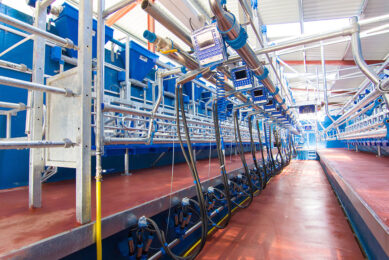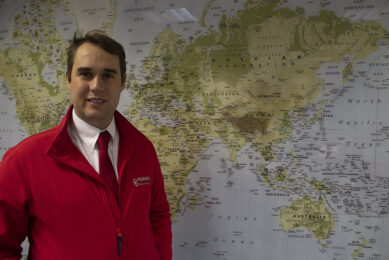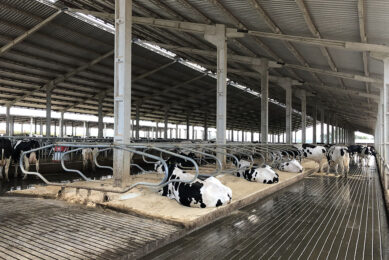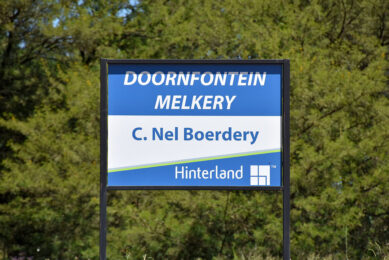“The future is automation of the carousel”
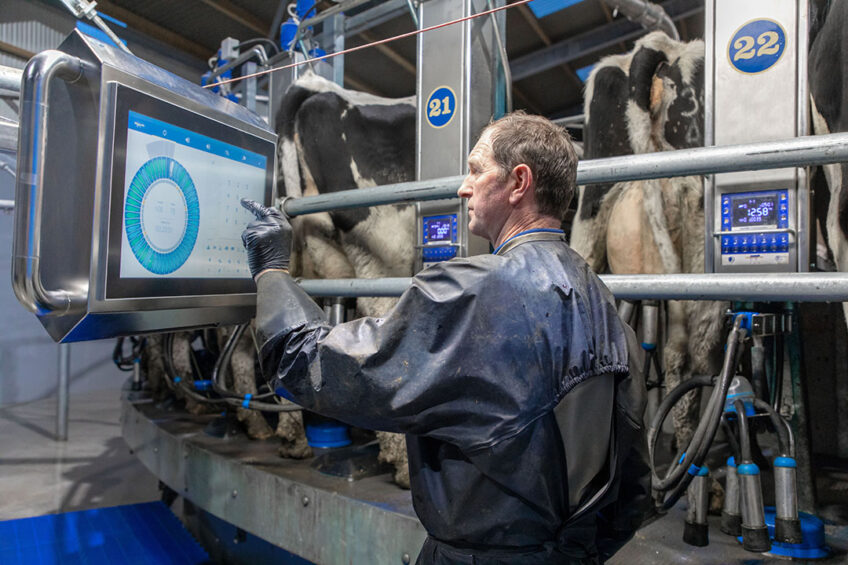
Less time in the milking parlour means healthier cows, less pressure on milkers and more efficient dairy farming. This can be achieved by automation of the conventional carousel to control the speed and to supply real time cow data. “We can reduce milking time by 20% to 30% and improve animal welfare at the same time,” says Rutger Schut from Europe Dairy Systems.
Rutger Schut is the CEO of Europe Dairy Systems and the main distributor in Europe for the Irish company Dairymaster, known for its high-tech milking solutions, it also produces feeding equipment, health and fertility monitoring systems, manure scrapers and milk cooling tanks. “The use of cow data to make dairy farming and the milking process more efficient is getting more and more important for dairy farmers around the world, reflected in the number of sensors launched over the last few years and the dashboards and management software programmes associated with them that are available to farmers.

These systems are getting more reliable and can help farmers improve profit, reduce working time, reduce veterinary costs and improve job satisfaction for example,” explains Schut. “Data is the future of milking. It is all about using real time cow or herd data, which allows the farmer to react much quicker to animal anomalies. This in turn will lead to a reduction of the production price of milk. And the latter is key in times where milk prices do not reach € 0.35 per litre. The low milk price is forcing farmers to measure more, react quicker and make better decisions. Dairymaster’s new Mission Control provides farmers with real-time performance indicators on the cow and herd, including attachment time, carousel downtimes, cow throughput, expected end of milking time, the status of the milk tank, remaining feed quantity, and animal health. This is the next step in data gathering and efficiency and we therefore put our product development on automation of carousel milking parlours.”
Control of platform speed
Efficiency in dairy farming is in focus because of a number of things, explains Schut. “Farmers struggle to find (skilled) milkers and the current milk prices challenge farmers to work more efficient to still make money from their cows. We therefore want to focus on making carousel milking parlours (known to milk many cows per hour) even more efficient, less reliant on manual work and equipped to observe cows better and react quicker. For us, that is the future of milking.” But automation of a conventional milking parlour such as a carousel doesn’t happen overnight and involves different aspects to consider and implement to make it work. According to Schut, Mission Control and OptiCruise are part of a whole new way of thinking about milking and the cow, which starts by getting the speed of the carousel under control. The speed control in the conventional milking parlours is currently based on the maximum capacity of the milker on duty.

This is for example 14 seconds per cow, so the milker put the speed of the carousel on a certain level. But when you want to automate this process, you have to know what the optimum speed of the carousel is. In practice, we see that some cows spend too much time in the milking parlour and we try to get all the cows out of the carousel as quickly as possible. Schut: “The feature called OptiCruise uses artificial intelligence and can help in doing this by automatically controlling the speed of the rotary platform.” As each cow steps on to the parlour, the OptiCruise knows the milking history of the cow, its expected milk quantity and the remaining milking time of the other cows already on the carousel. With this information, the system optimises carousel speed. Dr John Daly, research and innovation manager at Dairymaster also addresses the issue: “Even for experienced milkers, it’s not easy to get the carousel speed right. Our product is really to do with parlour control, rather than the actual milking side of it. It’s to do with the cow throughput and automatically adjusting the parlour speed based on the attachment speed of the operator. If Mission Control flags a problem and the farmer needs to stop or slow down the rotary to inspect a cow, OptiCruise takes account of the stoppage and automatically adjusts the speed of the carousel to recover that time.
This means farmers know they will be able to milk faster and take time to examine and treat problem cows, so it’s better for the animals and farmers.” Schut adds: “When there is a very slow milker in the group for example, we can decide to let her do another round in the carousel. The farmer can also easily select sick cows from the carousel. Overall, we can reduce the time spent in the parlour by 50 seconds per cow per milking. This means an efficiency improvement of 15-20%”. The data in Mission Control is constantly refreshed.
Milking clusters should not fall off
Next to speed control, labour reduction in the carousel barn can also be accomplished by making sure that the milking clusters don’t fall off. “We are advocating the natural way of milking and with our equipment we want to mimic nature and how the calf drinks. This means a high vacuum during milking and a low vacuum in the resting phase (in nature, this is the phase where the calf breaths in between drinking). It is all about getting the suck and release rhythm close to nature. This is better for the blood circulation in the teat and hence results in a better milk flow compared to other systems. The milking clusters catch less air and therefore hardly ever fall off,” explains Shut. Dairymaster therefore uses a vacuum pressure of 47 kpa during milking and 12 kpa during the resting phase. In a normal system, milking is done at 38 kpa during milking and 32 kpa in the resting phase. “By using a more natural flow, you create less pressure on the udder. Combined with a reduced time that the cow spends in the milking parlour, we see improvements in udder health,” says Schut.

Going for 100% accuracy
It is clear that Mission Control is a system that brings together different data points from different sources to create the most accurate information for the farmer, displayed on a screen in the milking parlour. The interface displays live information on every cow on the platform allowing the operator to take specific actions when necessary, for example, performing a milk test when SCC suddenly increases or withholding the milk from an animal during the withdrawal period.
Rumination is for example also an important measurement and data can give the farmer insights into the health status of the cow. “If our health and fertility monitoring system (MooMonitor+) detects a major dip in rumination, the cow often experiences a Salmonella infection or is dealing with ketosis. This will be flagged as soon as the cow enters the milking parlour and action can be taken by the farmer. The cow can be separated for treatment or the speed of the platform can be adjusted,” explains Schut. Mission Control which was previewed at Eurotier 2018 in Hanover, Germany where it won an innovation award is currently used on test farms, but Schut projects that this year the product will be commercially sold. “The test farms provide a huge amount of data that we need to make the system better and smarter. Data alone has no intrinsic value, it’s what you do with the data that creates value,” Schut concludes.



